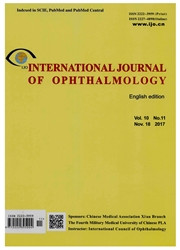

 中文摘要:
中文摘要:
AIM: To detect the mutations in two candidate genes, myocilin (MYOC ) and cytochrome P450 1B1 (CYP1B1 ), in a Chinese family with primary open angle glaucoma (POAG). ·METHODS:Thefamilywascomposedofthreemembers, the parents and a daughter. All members of the family underwent complete ophthalmologic examinations. Exons of MYOC and CYP1B1 genes were screened for sequence alterations by polymerase chain reaction (PCR) and direct DNA sequencing. ·RESULTS: The mother was the proband, she was diagnosed as POAG in both eyes. Her daughter was diagnosed as juvenile -onset POAG. The father was asymptomatic. One MYOC heterozygous mutation c.1150 G 】A (D384N) in exon 3 was identified in the mother, another MYOC heterozygous variation c.1058 C】T (T353I) in exon 3 was identified in the father, and the daughter inherited both of the variations. Meanwhile, three single nucleotide polymorphisms (SNPs) in CYP1B1 gene were found in the family. ·CONCLUSION: The D384N mutation of MYOC has been reported as one of disease-causing mutations in POAG, whereas T353I variation of MYOC was thought as a high risk factor for POAG. The two variations of MYOC were first reported in one juvenile -onset POAG patient whopresented with more severe clinical manifestations, suggesting that T353I polymorphism of MYOC may be associated with the severity of POAG.
 英文摘要:
英文摘要:
AIM: To detect the mutations in two candidate genes, myocilin (MYOC ) and cytochrome P450 1B1 (CYP1B1 ), in a Chinese family with primary open angle glaucoma (POAG). ·METHODS:Thefamilywascomposedofthreemembers, the parents and a daughter. All members of the family underwent complete ophthalmologic examinations. Exons of MYOC and CYP1B1 genes were screened for sequence alterations by polymerase chain reaction (PCR) and direct DNA sequencing. ·RESULTS: The mother was the proband, she was diagnosed as POAG in both eyes. Her daughter was diagnosed as juvenile -onset POAG. The father was asymptomatic. One MYOC heterozygous mutation c.1150 G >A (D384N) in exon 3 was identified in the mother, another MYOC heterozygous variation c.1058 C>T (T353I) in exon 3 was identified in the father, and the daughter inherited both of the variations. Meanwhile, three single nucleotide polymorphisms (SNPs) in CYP1B1 gene were found in the family. ·CONCLUSION: The D384N mutation of MYOC has been reported as one of disease-causing mutations in POAG, whereas T353I variation of MYOC was thought as a high risk factor for POAG. The two variations of MYOC were first reported in one juvenile -onset POAG patient whopresented with more severe clinical manifestations, suggesting that T353I polymorphism of MYOC may be associated with the severity of POAG.
 同期刊论文项目
同期刊论文项目
 同项目期刊论文
同项目期刊论文
 A novel MYOC heterzygous mutation identified in a Chinese Uygur pedigree with primary open-angle gla
A novel MYOC heterzygous mutation identified in a Chinese Uygur pedigree with primary open-angle gla Possible mechanism for the gastro-intestinal adverse effects upon topical application of Prostagland
Possible mechanism for the gastro-intestinal adverse effects upon topical application of Prostagland 期刊信息
期刊信息
